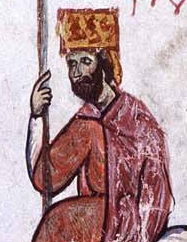Related Research Articles

Year 1011 (MXI) was a common year starting on Monday of the Julian Calendar.

Year 1017 (MXVII) was a common year starting on Tuesday of the Julian calendar.
The 1010s was a decade of the Julian Calendar which began on January 1, 1010, and ended on December 31, 1019.

Romanos III Argyros, or Argyropoulos was Byzantine Emperor from 1028 until his death. He was a Byzantine noble and senior official in Constantinople when the dying Constantine VIII forced him to divorce his wife and marry the emperor's daughter Zoë. Upon Constantine's death three days later, Romanos took the throne.
This is an alphabetical index of people, places, things, and concepts related to or originating from the Byzantine Empire. Feel free to add more, and create missing pages. You can track changes to the articles included in this list from here.

The Catepanateof Italy was a province of the Byzantine Empire from 965 until 1071. At its greatest extent, it comprised mainland Italy south of a line drawn from Monte Gargano to the Gulf of Salerno. North of that line, Amalfi and Naples also maintained allegiance to Constantinople through the catepan. The Italian region of Capitanata derives its name from katepanikion.
Argyrus was a Lombard nobleman and Byzantine general, son of the Lombard hero Melus. He was born in Bari.

Pandulf IV was the Prince of Capua on three separate occasions.

Melus was a Lombard nobleman from the Apulian town of Bari, whose ambition to carve for himself an autonomous territory from the Byzantine catapanate of Italy in the early eleventh century inadvertently sparked the Norman presence in Southern Italy. He was the first Duke of Apulia.

Basil Boioannes, in Italian called Bugiano, was the Byzantine catapan of Italy and one of the greatest Byzantine generals of his time. His accomplishments enabled the Empire to reestablish itself as a major force in southern Italy after centuries of decline. Yet, the Norman adventurers introduced into the power structure of the Mezzogiorno would be the eventual beneficiaries.
Guaimar III was the Lombard prince of Salerno from around 994 to his death. Under his reign, Salerno entered an era of great splendour. Opulenta Salernum was the inscription on his coins. He made Amalfi, Gaeta and Sorrento his vassals and annexed much of Byzantine Apulia and Calabria.
Kontoleon Tornikios was the Catapan of Italy from May to September 1017. He was originally the strategos of Cephallenia. As strategos, he accompanied the catapan Basil Mesardonites to Apulia in 1011. Basil died in 1016 and Leo was nominated to replace him, arriving in May. At the time, Melus of Bari had risen in revolt again, this time with a band of Normans. Leo sent Leo Passianos with an army against him. Passianos and Melus met on the Fortore at Arenula. The battle was either indecisive or a victory for Melus. Tornikios then took command himself and led them into a second encounter near Civita. This second battle was a victory for Melus, though Lupus Protospatharius and the anonymous chronicler of Bar record a defeat. A third battle, a decisive victory for Melus, occurred at Vaccaricia, near the site of later Troia. The entire region from the Fortore to Trani had fallen to Melus and in September, Tornikios was relieved of his duties in favour of Basil Boioannes.
Leo Passianos was the Byzantine general sent by the Catapan of Italy Leo Tornikios Kontoleon to fight the Lombard rebel Melus of Bari in 1017. He is not to be confused with the other Passianos killed in Melus' first rebellion while fighting the Saracens under Ishmael of Montepeloso.
John Kourkouas or Curcuas was the Byzantine catepan of Italy from 1008 to 1010.
Dattus was a Lombard leader from Bari, the brother-in-law of Melus of Bari. He joined his brother-in-law in a 1009 revolt against Byzantine authority in southern Italy.

The Norman conquest of southern Italy lasted from 999 to 1139, involving many battles and independent conquerors.
Basil Onomagoulos was a Byzantine official who was declared rival emperor in Sicily in 717, taking the regnal name Tiberius.
Basil Argyros was a Byzantine nobleman and general of the Argyros family and a brother of the emperor Romanos III. Basil was the maternal grandfather of emperor Romanos IV Diogenes.
Atenulf was the Abbot of Montecassino from 1011 until his death. He was a cousin of Prince Pandulf II of Capua, a younger son of Prince Pandulf III and brother of Prince Pandulf IV.
References
- ↑ Lupus Protospatharius, as per the Byzantine convention, places the start of each calendar year in September, hence events placed on a given year may have actually occurred late in the preceding year.
- ↑ Kazhdan, Alexander. Some Notes on the Byzantine Prosopography of the Ninth through the Twelfth Centuries. Byz. Forsch. 12 (1987): 63–76.